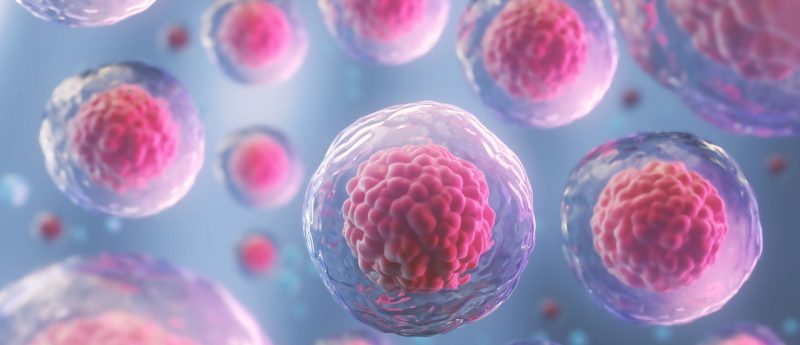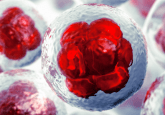Optimize bioprocessing from bench to production: an interview with Philipp Nold

In this interview, Philipp Nold (Eppendorf, Hamburg, Germany) discusses challenges and pitfalls in bioreactor-based stem cell bioprocessing and shares his experience and tips for overcoming these.
Please introduce yourself and your institution?
My name is Philipp Nold and I work as an Application Specialist for Stem Cells at the Eppendorf Bioprocess Center in Jülich (Germany). After obtaining my diploma in Biology from the Karlsruhe Institute of Technology (KIT; Germany), I successfully performed my PhD studies at the renowned University Hospital of Giessen and Marburg in Germany where I graduated in 2017. In my PhD studies, I conducted research on the GMP-compliant production of human mesenchymal stem cells in bioreactors. Based on this work, utilization of these cells as a therapeutic agent was applied successfully.
In December 2017, I joined the Eppendorf Bioprocess Center as an Infield Application Specialist for Stem Cells. As part of this, I support customers and colleagues worldwide with my consolidated expertise in stem cell bioprocessing and applications. This includes training, presentations at conferences and webinars.
Eppendorf provides sophisticated bioreactor control systems. How have the needs of manufacturers changed over recent years?
We have seen a decrease of batch sizes and a shift from blockbuster drugs to a more individualized and targeted therapy for patients especially in the field of cell therapy. Therefore, the need for more efficiency in research and developing and manufacturing of those cells or cell-based drugs is constantly rising. Because of the rapidly growing, individualized cell-therapy demands bioprocessing is turning to the implementation of single-use technology (SUT), using the advantages of faster turnaround times due to reduced cleaning requirements, increased flexibility, eased handling and more. Our BioBLU Single-Use bioreactors combine all the advantages of single-use technology with the trusted performance and scalability of a stirred-tank design.
All these processes generate huge amounts of data. By integrating design of experiments (DoE), process analytical technology (PAT) and multivariate data analysis into the SCADA software, you will be able to best utilize this data to your advantage. By using artificial intelligence, the system can support optimization of its own process based on generated data in the past and/or even from the current run. This will lead to improved process control resulting in higher cell yields and therefore in optimized process economy.
What are the advantages and challenges of using automation in bioreactor control?
Automation can set your process to the next level. For example, using automated feed additions based on measured parameters will not only ease handling by reducing the manual work of your process but also helps standardize the process and will therefore contribute meaningfully to product quality.
The challenge of using automation comes from having to define parameters and reacting to aberrations. Using our sophisticated SCADA software, automation is achieved easily and comprehensively. By using scripting possibilities and the seamless integration of third-party equipment, simple rules up to complex programs can be defined to reduce manual work to a minimum. By reducing human interventions into the process, the risk of contamination is minimized. Again, this contributes to a less error prone, streamlined process and will contribute to a higher product quality.
What critical process parameters should be monitored during production and how might they change from early process development to pilot scale production?
Our bioreactors have the big advantage of not only to monitoring but also to controlling multiple process parameters in parallel. For example, pH is known to be a critical parameter in terms of influencing cells. Growing cells constantly secret lactate which leads to a constant acidification of the medium, if the pH is not properly controlled. The ability to control the pH at a desired setpoint over the whole process has been shown to result in more cells compared to a process, where the pH is not tightly controlled.
Besides pH, dissolved oxygen (DO) has a big impact on the cells fate; stem cells reside in vivo in in a very low oxygen compartment called the niche to preserve their potential and their differentiation capabilities. To mimic this environment, DO control is mandatory. Furthermore, the agitation needs to be controlled to achieve homogenous culture conditions in the bioreactor keeping also an eye on power input into the system.
High titer, robustness of the process, constant product quality, fast turn-around time, and scalability are some of the success factors that need to be considered. It is important to work with bioreactors that are comparable with bench-, pilot- and production-sized bioreactors.
Keeping in mind critical scalability-related engineering parameters like proportional vessel/impeller geometry, oxygen transfer rate (OTR), impeller power number (Np), and the impeller power consumption per volume (P/V) helps to optimize the process and ultimately leads to successful scale-up strategy.
What common pitfalls are there in bioreactor process development?
A common pitfall that we face in our daily interaction with customers is that the transition from 2D culture into 3D systems is being executed at a late time point in process development, often when the need for more cells is rising. Processes are then transferred into a new platform which often means cumbersome process adaptions. Especially in the field of cell therapies, regulatory aspects come into play were whole workflows needs to be validated again, meaning process development from the start. However, when a process is already bioreactor-based, one must have the transferability to larger vessel sizes in mind. Factors like power input, oxygen transfer, tip speed and more are engineering parameters used to scale-up the process into larger volumes. Our systems and vessels are designed to allow an easy scale-up by using the well-established stirred tank technology together with matching SCADA system that allows seamless transition of process by maintaining product quality.
How do impeller characteristics determine resultant cell characteristics?
It is important to choose the right impeller type for your process. In microbial applications, where high oxygen transfer rates are needed, Rushton-type impellers are used to agitate these robust cells. In cell culture and especially in stem cell processes, much lower oxygen transfer rates and more gentle mixing capabilities are needed. By using special impeller types, like a pitched-blade impeller, one could overcome detrimental effects on the cells by gently keep the cells in uniform suspension without harming them.
Together with scientists from the Hannover Medical School (MHH; Germany), we developed a special 8-blade impeller for stem cell processing in our vessels. This impeller was designed to keep induced pluripotent stem cell (iPSC) aggregates (also useful for microcarrier-based processes) in homogeneous suspension already at very low agitation. It has also been shown that controlling the agitation number one could control the size of iPSC aggregates to the desired number of cells composing them. This is of utmost importance to avoid detrimental effects like senescence and even necrotic cells at the core of the aggregate that will occur if aggregates grow too big. Stirring at too low rpms will result in settlement of the aggregates or also microcarriers on the ground of the vessel leading to detrimental supply of nutrients, oxygen and pH deviation in that compartment.
So, the right impeller type and agitation speed is important to obtain optimal results.
Will iPSCs suffer from the impeller used in a bioreactor?
Bioprocessing stem cells in stirred-tank bioreactors is done successfully by many customers from industry and academia all over the world. Using special impeller types, like a pitched-blade impeller, or the mentioned 8-blade impeller, helps to gently keep the cells in uniform suspension without harming them. Besides agitation factors like pH or DO, also the process type, for example batch, fed batch or perfusion, has been shown to have a big impact on viability, cell number, cell potential and differentiation potential. The opportunity to control and monitor these parameters is, besides scalability, a big advantage that bioreactors can provide. In the end it is all about knowing and controlling your process. Bioreactors are designed to help you in develop, optimize, scale-up your process by providing sophisticated monitoring and controlling opportunities.
How might use of bioreactors and automated monitoring develop in the future?
In future the requirement of future-proof solutions that can evolve with the needs of the market change will rise. Imagine what will happen when a new novel sensor type enters the market, with unique electronics associated with it? Rather than having to redesign an entire electronics platform, it would be ideal to be able to adapt to the new needs, so in this example, the sensor can be connected to the controller and digitally integrated.
Our new SciVario® twin bioreactor control system, part of a bioprocess controller platform for all future Eppendorf small and bench-scale devices, was designed with adaptability in mind. The SciVario twin is built off Eppendorf’s VisioNize® architecture, a controller allowing the seamless integration and communication across all of our products in the lab by sharing information models. The SciVario twin also includes configurable bay-drawers, so rather than having to buy new products as your needs change, additional bays can be integrated to ensure adaptability to your process. The goal is that, once a product is in your lab, any new features that become available can be add-ons, making it unlikely someone would need to buy an entirely new instrument for at least five to 10 years.
How can people contact you if they would like more information?
You can email me here: [email protected]
